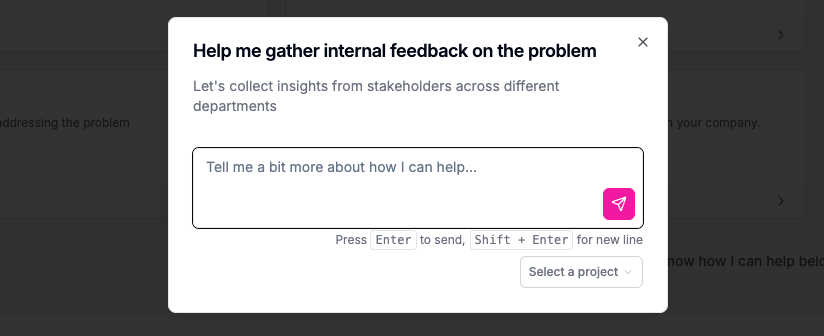
Why Use This Template
Stakeholder interviews serve several critical purposes in your AI procurement journey:- Validate the problem: Confirm that the issue is significant enough to warrant investment
- Quantify the impact: Gather metrics that demonstrate the business cost of the current situation
- Build consensus: Engage stakeholders early to reduce resistance later
- Collect diverse perspectives: Understand how the problem affects different teams
- Identify hidden requirements: Discover needs that might not be obvious initially
Template Structure
The Stakeholder Feedback template includes:1. Stakeholder Impact Map
This section helps you identify which stakeholders to interview based on how they’re affected by the problem:2. Meeting Agenda Template
A structured interview format to ensure you cover all important aspects of the problem:3. Meeting Talk Track
Detailed speaking points for each section of the agenda to help guide the conversation effectively:Welcome and Context Example
Welcome and Context Example
How to Use This Template
- Identify stakeholder categories relevant to your AI initiative
- Create a stakeholder impact map to determine who to interview
- Schedule individual or group interviews with key stakeholders
- Customize the agenda and talk track for each stakeholder type
- Conduct the interviews, taking detailed notes
- Synthesize findings to identify patterns and quantify the problem
Example: Vector Database Stakeholder Interview
Here’s how the template was applied for a company evaluating a Vector Database platform:Vector Database Platform Example
Vector Database Platform Example
Key Stakeholder Categories for AI Projects
When planning your stakeholder interviews for an AI initiative, consider including representatives from these groups:Executive Sponsors
Budget holders and strategic decision makers who care about ROI, strategic alignment, and risk management
Direct Users
Day-to-day users affected by the problem who can provide insights on workflow disruptions and practical challenges
Technical Stakeholders
IT, security, and implementation teams who can identify integration requirements and technical constraints
Process Owners
Managers and team leads responsible for affected processes who can speak to broader operational impacts
Support Functions
Legal, procurement, and finance teams who can highlight compliance, budgeting, and vendor management considerations
External Stakeholders
Customers or partners affected by the problem who can provide an outside perspective on its impact
Best Practices for Effective Stakeholder Interviews
- Prepare thoroughly: Customize your questions for each stakeholder’s role and perspective
- Listen more than you talk: Aim for the stakeholder to speak 80% of the time
- Ask open-ended questions: “How” and “why” questions yield richer insights than yes/no questions
- Capture metrics: Collect specific numbers that quantify the problem’s impact
- Follow the unexpected: Be willing to explore new angles that emerge during the conversation
- Summarize and verify: At the end, recap key points to ensure you’ve understood correctly
- Show appreciation: Thank stakeholders for their time and insights
Next Steps After Stakeholder Interviews
Once you’ve completed your stakeholder interviews, you can:- Create a problem statement that synthesizes the feedback
- Build a business case for addressing the identified problem
Business Case Template
Ready to kick off your buying project? Use our Business Case template to build alignment around your idea.

